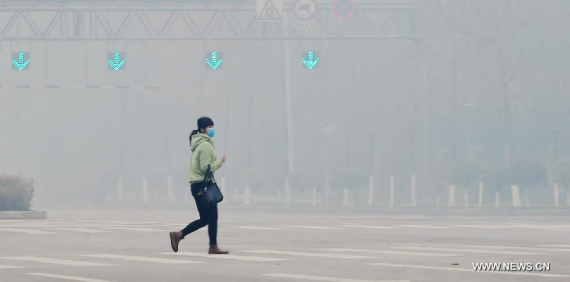
A woman walks on a smog-shrouded road in Shenyang, northeast China's Liaoning Province, Nov. 8, 2015. (Photo: Xinhua/Yang Qing)
Smog in northeastern Chinese provinces throughout the weekend showed no signs of dispersing, prompting local governments to take emergency measures.
Density of PM2.5, airborne particles smaller than 2.5 microns in diameter, reached extremely high levels across the region, slashing visibility, grounding flights and closing highways.
PM2.5 concentration went off the charts in Shenyang, capital of Liaoning. The air-quality index (AQI) in six cities in the province exceeded the maximum of 500 on Sunday. Eight of the 14 cities were still labeled as "seriously polluted" on Monday.
Patients with respiratory ailments jammed local hospitals. Face masks were sold out.
The AQI in Changchun, capital of Jilin Province, topped 500, reducing the visibility in downtown areas to less than 100 meters.
According to the provincial transport department, 87 flights were delayed or canceled as of 8 a.m. on Monday. Highways connecting Changchun and other cities in the province were completely or partially closed.
The local meteorological department blamed winter heating, crop burning, a relatively weak cold front and recent rain and snow.
Besides issuing emergency warnings, local governments have taken measures to counter the worst smog of the year.
Liaoning ordered all environmental employees to be on call 24 hours a day and sent staff to monitor emissions at key factories.
Zhu Jinghai, Liaoning's provincial environment head, said 14 teams had been dispatched to 14 cities in the province to make sure all the emergency measures are strictly adhered to.
In Changchun, an emergency action plan urged citizens to stay indoors. Schools and kindergartens were asked to stop organizing outdoor activities and take protective measures.
The local government instructed industrial enterprises to limit production or halt manufacturing, suspended construction work and road excavation, and banned crop residue burning and fireworks.
Local meteorological, transport and environment departments released and updated information and travel advice via traditional channels such as radio and TV, and social media including WeChat, Weibo and mobile apps.
HEATING, BURNING STRAW
Experts attribute the acrid smog in northeast China to several causes, including winter heating and burning straw.
Zhang Bin, an official with Changchun city environmental protection department, blamed the region's foul air on coal burning for winter heating.
"Many cities in China, including the northeastern provinces, use coal as the major heat generator, which pushes up air pollution levels," Zhang said.


















































